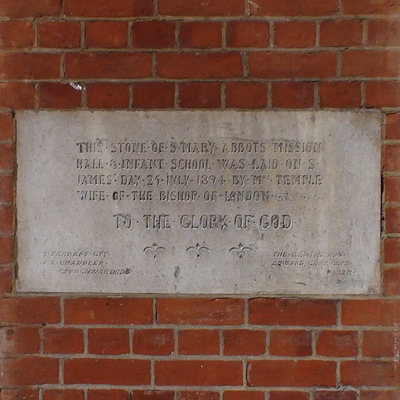West Square celebrated its centenary in September 1991. We can do no better than repeat the excellent text that the West Square Residents Association has provided on a notice board at the gate:
"The Square was built on land belonging to the West family (hence its name) which lay to the east of the Dog & Duck tavern, later the site of the Bethlem Hospital and now the Imperial War Museum. It was the largest of several plots of land in what were known in the 18th Century as St George’s Fields, being in the Parish of St George the Martyr, a church still extant by Borough Underground station. Colonel Temple West died in 1784, leaving his estate in St George’s Fields to his wife and eldest son. They were empowered by his will to make leases. In 1791 they granted building leases on the site of what was to become West Square to Thomas Kendall and James Hedger. Many of the houses were completed and occupied by 1794. The Square was intended to be symmetrical and houses on the west side are grouped formally as a terrace, with the two centre houses (13 & 14) surmounted by a pediment, and those adjoining them on either side are set forward slightly, as are the two at each end.
Most of the houses were four storeys but 25 – 28 on the south side were when built the highest houses in south London. 29 – 32 on the east were built later and are also five storeys. 20, the largest house in the Square, was once a school. In 1795 the Admiralty installed shutter telegraph apparatus, to convey messages to New Cross and thence Chatham and Sheerness, on 36, the centre house on the east side. In 1812 the erection of a dome on the roof of the new Bethlem Hospital obstructed the view from Whitehall and a tower had to be added, removing the pediment. It is still distinctive with its bow window and raised top storey while its pair 37, had the first mansard. Many other houses had mansard roofs added later to give an extra storey, but uniformity on the west side has been maintained, with mansards only on the end houses.
During the early 20th Century the standing of the area declined and most were converted into flats and multiple occupation. The west side suffered from lateral conversion to flats across several properties, with doorways blocked, staircases altered and external pipework. The north side houses were lost, 1 - 5 to the London Schools Board West Square school, and 46 – 50 to replica properties with the creation of new houses behind, known as Temple West Mews, in the 1970s. Over the last 30 years, with its fortunes restored, most houses have been returned to single household occupation and their appearance renovated. On the west side, where only a pair survive as a lateral conversion, the integrity of the terrace has been nicely recreated. Orient Street, in the SE corner, has a house (1) that may predate most of the Square, with an elaborate portico doorway. The adjoining houses are the survivors of a once extensive range of cottages probably intended for grooms and coachmen. At the end of the street was a large range of coach houses, with a horse scratching post now the only reminder of that era. Some coach houses were used as warehouses in recent years but were demolished in the 1980s to make way for a street of new houses named for James Hedger the builder.
Robert Barker, who painted panoramas and exhibited them in Leicester Square, lived at 14, 1799 – 1806, and his son, who assisted him in this work, married a daughter of Admiral Bligh (of the Bounty and Lambeth Road) lived at 13, 1802 – 1824. Hedger lived in South (now Austral) Street, his garden extending along the back of West Square and there were also mews or stables in this street prior to the present Victorian housing. Charlotte Sharman, the philanthropist (1832 – 1929), after whom the school is named, ran an orphanage in the Square living at 23 and later constructed a large building in Austral Street; it is now the All Saints Hospital annexe to the War Museum. 19 was home to John A. R. Newlands (1837 – 98) the chemist who discovered the periodic table of the elements. Charlie Chaplin lived briefly in West Square as a boy.
The garden in West Square was laid out with mulberry trees, though the present trees, leaning since the great storm of 1987, are not the original, and with one lost several young ones have been planted as replacements. The garden has always been open to the general public and is now maintained by the London Borough of Southwark, The Square is a Conservation Area, and the buildings are Listed. It is also within the “Division Bell Area” of parliament making it popular place for politicians to live."
Our image shows the telegraphic tower in 1827. That website also has a drawing of the building in which Barker painted his panoramas.
See Telegraph Cottage for a telegraph station on another route.










Comments are provided by Facebook, please ensure you are signed in here to see them